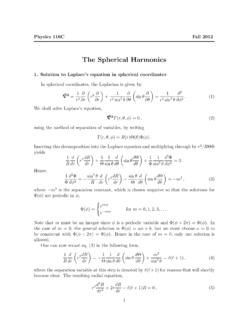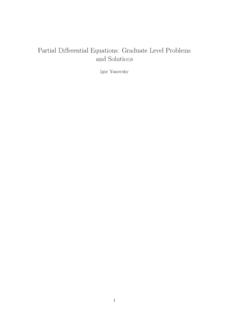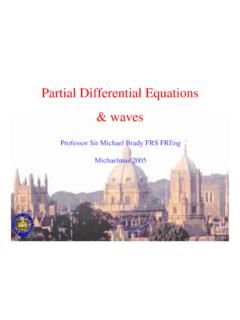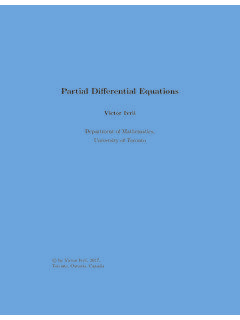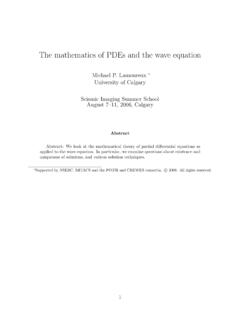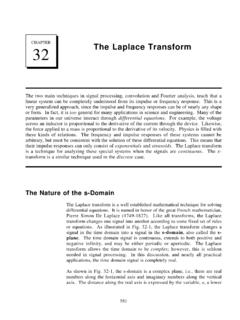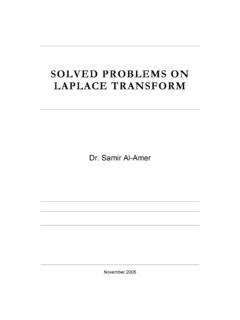Transcription of Laplace Transform solved problems - Univerzita Karlova
1 Laplace Transform solved problems Pavel Pyrih May 24, 2012. ( public domain ). Acknowledgement. The following problems were solved using my own procedure in a program Maple V, release 5, using commands from Bent E. Petersen: Laplace Transform in Maple peterseb/mth256/docs/256winter2001 All possible errors are my faults. 1 Solving equations using the Laplace Transform Theorem.(Lerch) If two functions have the same integral Transform then they are equal almost everywhere. This is the right key to the following problems . Notation.(Dirac & Heaviside) The Dirac unit impuls function will be denoted by (t). The Heaviside step function will be denoted by u(t).
2 1. Problem. Using the Laplace Transform find the solution for the following equation . y(t) = 3 2 t t with initial conditions y(0) = 0. Dy(0) = 0. Hint. no hint Solution. We denote Y (s) = L(y)(t) the Laplace Transform Y (s) of y(t). We perform the Laplace Transform for both sides of the given equation. For particular functions we use tables of the Laplace transforms and obtain 1 1. s Y(s) y(0) = 3 2 2. s s From this equation we solve Y (s). y(0) s2 + 3 s 2. s3. and invert it using the inverse Laplace Transform and the same tables again and obtain t2 + 3 t + y(0). With the initial conditions incorporated we obtain a solution in the form t2 + 3 t Without the Laplace Transform we can obtain this general solution y(t) = t2 + 3 t + C1.
3 Info. polynomial Comment. elementary 2. Problem. Using the Laplace Transform find the solution for the following equation . y(t) = e( 3 t). t with initial conditions y(0) = 4. Dy(0) = 0. Hint. no hint Solution. We denote Y (s) = L(y)(t) the Laplace Transform Y (s) of y(t). We perform the Laplace Transform for both sides of the given equation. For particular functions we use tables of the Laplace transforms and obtain 1. s Y(s) y(0) =. s+3. From this equation we solve Y (s). y(0) s + 3 y(0) + 1. s (s + 3). and invert it using the inverse Laplace Transform and the same tables again and obtain 1 1. + y(0) e( 3 t). 3 3. With the initial conditions incorporated we obtain a solution in the form 13 1 ( 3 t).
4 E 3 3. Without the Laplace Transform we can obtain this general solution 1. y(t) = e( 3 t) + C1. 3. Info. exponential function Comment. elementary 3. Problem. Using the Laplace Transform find the solution for the following equation . ( y(t)) + y(t) = f(t). t with initial conditions y(0) = a Dy(0) = b Hint. convolution Solution. We denote Y (s) = L(y)(t) the Laplace Transform Y (s) of y(t). We perform the Laplace Transform for both sides of the given equation. For particular functions we use tables of the Laplace transforms and obtain s Y(s) y(0) + Y(s) = Laplace (f(t), t, s). From this equation we solve Y (s). y(0) + Laplace (f(t), t, s).
5 S+1. and invert it using the inverse Laplace Transform and the same tables again and obtain Z t y(0) e( t) + f( U1 ) e( t+ U1 ) d U1. 0. With the initial conditions incorporated we obtain a solution in the form Z t a e( t) + f( U1 ) e( t+ U1 ) d U1. 0. Without the Laplace Transform we can obtain this general solution Z. y(t) = e( t) f(t) et dt + e( t) C1. Info. exp convolution Comment. advanced 4. Problem. Using the Laplace Transform find the solution for the following equation . ( y(t)) + y(t) = et t with initial conditions y(0) = 1. Dy(0) = 0. Hint. no hint Solution. We denote Y (s) = L(y)(t) the Laplace Transform Y (s) of y(t). We perform the Laplace Transform for both sides of the given equation.
6 For particular functions we use tables of the Laplace transforms and obtain 1. s Y(s) y(0) + Y(s) =. s 1. From this equation we solve Y (s). y(0) s y(0) + 1. s2 1. and invert it using the inverse Laplace Transform and the same tables again and obtain 1 t 1. e + y(0) e( t) e( t). 2 2. With the initial conditions incorporated we obtain a solution in the form 1 t 1 ( t). e + e 2 2. Without the Laplace Transform we can obtain this general solution 1 t y(t) = e + e( t) C1. 2. Info. exponential function Comment. elementary 5. Problem. Using the Laplace Transform find the solution for the following equation . ( y(t)) 5 y(t) = 0. t with initial conditions y(0) = 2.
7 Dy(0) = b Hint. no hint Solution. We denote Y (s) = L(y)(t) the Laplace Transform Y (s) of y(t). We perform the Laplace Transform for both sides of the given equation. For particular functions we use tables of the Laplace transforms and obtain s Y(s) y(0) 5 Y(s) = 0. From this equation we solve Y (s). y(0). s 5. and invert it using the inverse Laplace Transform and the same tables again and obtain y(0) e(5 t). With the initial conditions incorporated we obtain a solution in the form 2 e(5 t). Without the Laplace Transform we can obtain this general solution y(t) = C1 e(5 t). Info. exponential function Comment. elementary 6. Problem.
8 Using the Laplace Transform find the solution for the following equation . ( y(t)) 5 y(t) = e(5 t). t with initial conditions y(0) = 0. Dy(0) = b Hint. no hint Solution. We denote Y (s) = L(y)(t) the Laplace Transform Y (s) of y(t). We perform the Laplace Transform for both sides of the given equation. For particular functions we use tables of the Laplace transforms and obtain 1. s Y(s) y(0) 5 Y(s) =. s 5. From this equation we solve Y (s). y(0) s 5 y(0) + 1. s2 10 s + 25. and invert it using the inverse Laplace Transform and the same tables again and obtain t e(5 t) + y(0) e(5 t). With the initial conditions incorporated we obtain a solution in the form t e(5 t).
9 Without the Laplace Transform we can obtain this general solution y(t) = t e(5 t) + C1 e(5 t). Info. exponential function Comment. elementary 7. Problem. Using the Laplace Transform find the solution for the following equation . ( y(t)) 5 y(t) = e(5 t). t with initial conditions y(0) = 2. Dy(0) = b Hint. no hint Solution. We denote Y (s) = L(y)(t) the Laplace Transform Y (s) of y(t). We perform the Laplace Transform for both sides of the given equation. For particular functions we use tables of the Laplace transforms and obtain 1. s Y(s) y(0) 5 Y(s) =. s 5. From this equation we solve Y (s). y(0) s 5 y(0) + 1. s2 10 s + 25. and invert it using the inverse Laplace Transform and the same tables again and obtain t e(5 t) + y(0) e(5 t).
10 With the initial conditions incorporated we obtain a solution in the form t e(5 t) + 2 e(5 t). Without the Laplace Transform we can obtain this general solution y(t) = t e(5 t) + C1 e(5 t). Info. exponential function Comment. elementary 8. Problem. Using the Laplace Transform find the solution for the following equation 2. y(t) = f(t). t2. with initial conditions y(0) = a Dy(0) = b Hint. convolution Solution. We denote Y (s) = L(y)(t) the Laplace Transform Y (s) of y(t). We perform the Laplace Transform for both sides of the given equation. For particular functions we use tables of the Laplace transforms and obtain s (s Y(s) y(0)) D(y)(0) = Laplace (f(t), t, s).


